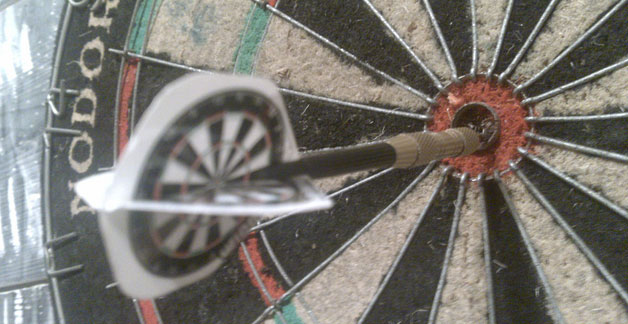What Playing on the Mouthpiece Alone Can Tell You About Your Pitch
 For most of us, playing on the mouthpiece alone results in a horrible noise much resembling what I’d imagine a duck in heat sounds like upon encountering a potential partner. But believe it or not, that horrid noise holds the truth of your current state of intonation.
For most of us, playing on the mouthpiece alone results in a horrible noise much resembling what I’d imagine a duck in heat sounds like upon encountering a potential partner. But believe it or not, that horrid noise holds the truth of your current state of intonation.
So here’s the deal – take the mouthpiece, with the reed attached (of course), and blow through it, loud and clear as you would if you were practicing your long tones. Depending on the horn you’re playing, here are the notes that blowing naturally through the mouthpiece should automatically produce as outlined by Dr. Brian R. Utley:
- Soprano saxophone: concert C3
- Alto saxophone: concert A2
- Tenor saxophone: concert G2
- Baritone saxophone: concert D2
The Goal
The goal, of course, is to play these notes in tune and take note of your embouchure, the shape of your oral cavity, and the throat (more about that in a second). The shape of the oral cavity can be altered by the position of the soft palate (ie: the soft tissue at back of the roof of your mouth) and the tongue. Dr. Utley suggests that the position of the tongue can affect your pitch, with a tongue positioned too high resulting in sharpness, and a tongue too low producing flatness. If you’re playing the target note in tune, then it means that the embouchure, oral cavity, and throat are set for optimum intonation as well as tonal quality .
Using the Throat
Perhaps most key to the control over the pitch is the position of the throat. One common exercise is to put your hand around the front of your throat, sing a note, and then jump up an octave. Feel how the position of your throat changes? Well, same goes for when you’re playing the sax. The position of your throat should change in the same way for each note you play.
This, of course, takes a lot of practice since the movement of the throat becomes much more subtle when we’re moving in between half and whole notes – not to mention when we’re tuning. Practicing overtones and mouthpiece exercises are great ways to develop the skill of controlling your pitch without lipping up or down.
A Matter of Opinion
Now, not everyone agrees that the list above represents the notes that are supposed to come out when the mouthpiece is played alone. In fact, some teachers feel that any note within a small range of the notes above will do. For classical saxophone, the range is about one half-step above or below the list of aforementioned target notes. However, for jazz saxophone, the range of notes is quite a bit wider, since we’re generally dealing with a looser embouchure and the target pitch could be a bit lower than with the classical approach. For more info on the range of target pitches to go for, check out this interesting little PDF file.
Don’t Psych Yourself Out
Assuming that you’re using a tuner to check up on the pitch of these notes, make sure to start the note without looking at your tuner. Otherwise, you might find yourself immediately making adjustments, thereby only reinforcing the feeling of making quick adjustments. What we’re really looking for here is where the pitch actually lies when we’re playing as we would normally play. So go ahead and hit that note without thinking about your pitch, and then check to see where your pitch actually ends up sitting.
So There You Have It
Instead of wandering around the vast expanse of embouchure, inner mouth, and throat possibilities, you now have the tools to guide yourself towards your optimum tonal capabilities. So you have no excuse, get out there and start doing some serious quackin’ – so that your horn can do some serious singin’!
Photo by markhillary






February 26, 2012 @ 8:31 am
Thanks for another great stimulus for discussion! Mouthpiece playing is a great tool for the tool box.
A few things to add to the conversation.
-Use a lot of air or it won’t work. (if your pitch is too high, think of pushing the pitch down, not pulling it down. Like pushing a beach ball under water.)
-Sing the pitch first so you know you know what you’re aiming for.
-Play mf to start, crescendo to ff, and then back off to pppp to make sure you can maintain the right balance at all dynamic levels. (You’ll tend to go extremely sharp when playing soft. . . hold that pitch down)
-Benefits include better pitch AND a fuller, textured sound on the saxophone, greater flexibility (over the break, for example), and consistency of tone/pitch at all dynamic levels.
-Jazz AND classical players alike occasionally have to bend pitch, scoop, or swoop between pitches. So, find that target pitch and bend the pitch down as far as you can go and back and forth (which takes MORE air for lower notes — remember the beach ball). A perfect 4th is a good target interval for starters. If you can do that, you’ve learned what it takes to scoop and swoop just like Johnny Hodges. (See also: mouthpiece exercises above)
-Find a teacher or another player that can do this to help you out or demonstrate. It is very difficult for some players to figure out how exactly to get a solid pitch on the mouthpiece on their own.
-Be patient — if it doesn’t work for you right away, have a laugh over the funny sounds you make and try again tomorrow.
Thanks again, Doron — great content!
February 26, 2012 @ 10:53 am
These are great tips, thanks Brad! And it’s very true what you say about the challenge of doing this with varied dynamics. This is definitely a challenging technique, but man, the rewards are worth it.
September 26, 2013 @ 11:45 am
Hi Doron,
that “interesting little pdf” is more than just “little”. For me it was like a light bulb switched on. One always reads that the mouthpiece pitch for tenor should be concert G (or close to that). Learning that a lower mpc pitch is not “wrong” and may result in a richer tone gave me hope to finally improve my tone after years of sound frustration. I found similar stuff on a great german sax site: if you push the mpc a bit to far on the neck (what normally results in a sharp tone) you can lower the pitch with your voicing/inner embouchure and get a bigger sound. Seems that a lower mpc pitch is gained by a more open throat (I know you abandoned the “open throat theory” – but: what ever works)
Thanks for this big little info!
PS: I have a baby myself – running that cool site AND caring for a baby – man you must be some workaholic!
September 30, 2013 @ 7:29 pm
Thanks Rüdiger, I’m *so glad* that I could help! And yes, I am indeed super-busy, but it’s all great stuff, wish I could do even more!
June 21, 2016 @ 8:49 am
Can someone re-post the intersting little pdf? the link is broken and I’m very interested
July 12, 2020 @ 8:23 pm
Hi Doron. I saw this article earlier and you included a MP3 with the tones so that one had a target to shoot for with the PDF. It isn’t referenced in this article. Can you provide a link to the MP3? Thanks.
July 13, 2020 @ 12:28 pm
Hello George, I am not sure which mp3 you’re referring to – I believe that there are more than one articles that reference playing on the mouthpiece alone, but I just did a search and could not find one. Do you think that perhaps it was another article?
July 12, 2023 @ 11:24 am
I think the concert tone numbers are wrong, Tenor should be G5 not G2
July 19, 2023 @ 6:12 am
Hello Peter! As it happens, the pitches I have listed are coming from the article I linked to here: https://tsmp.org/band/saxophone/utley_buzzing_mouthpiece.html.
However, I am curious to get your thinking on this – any reason you’re thinking G5 for the tenor as opposed to what’s listed in the article?